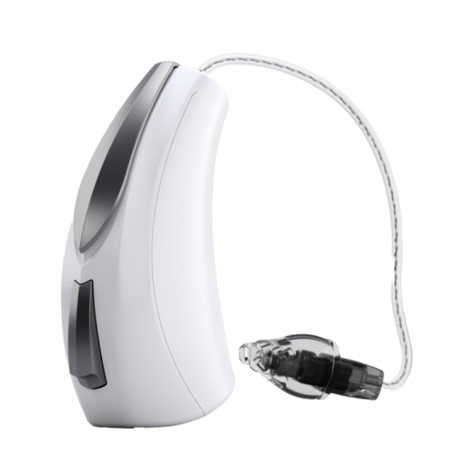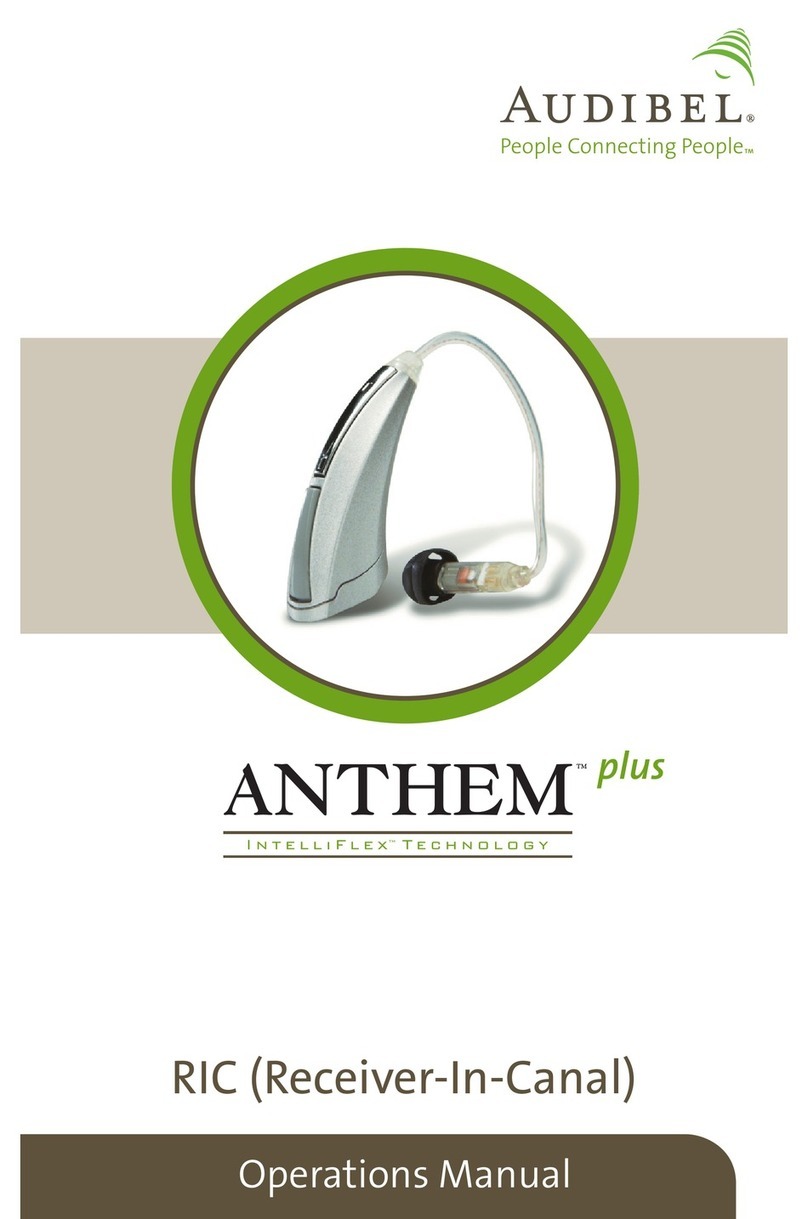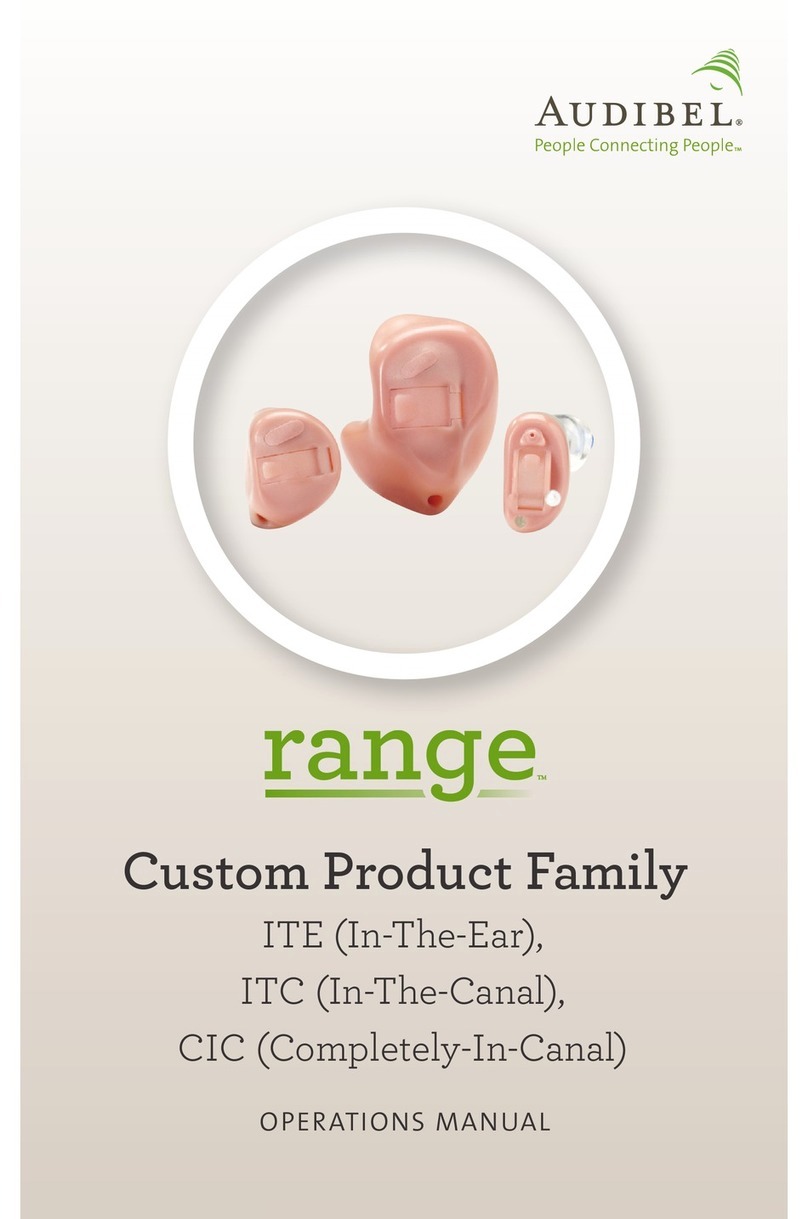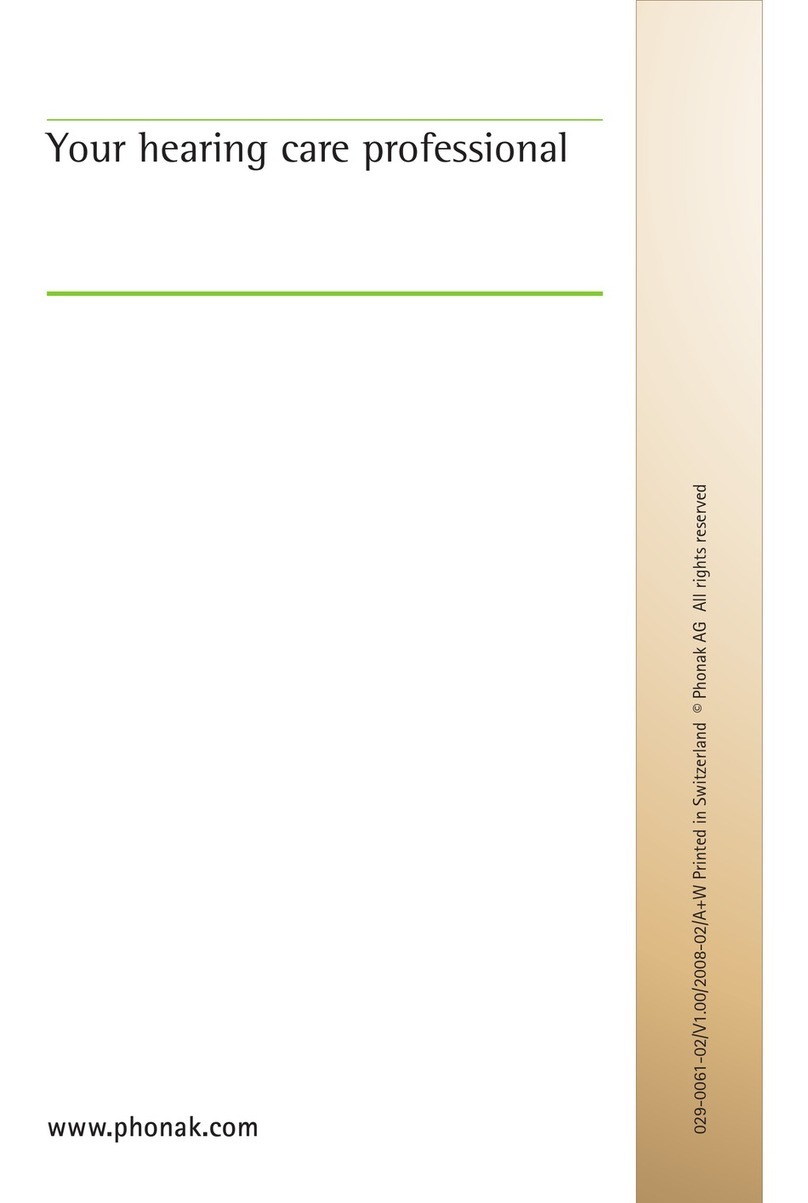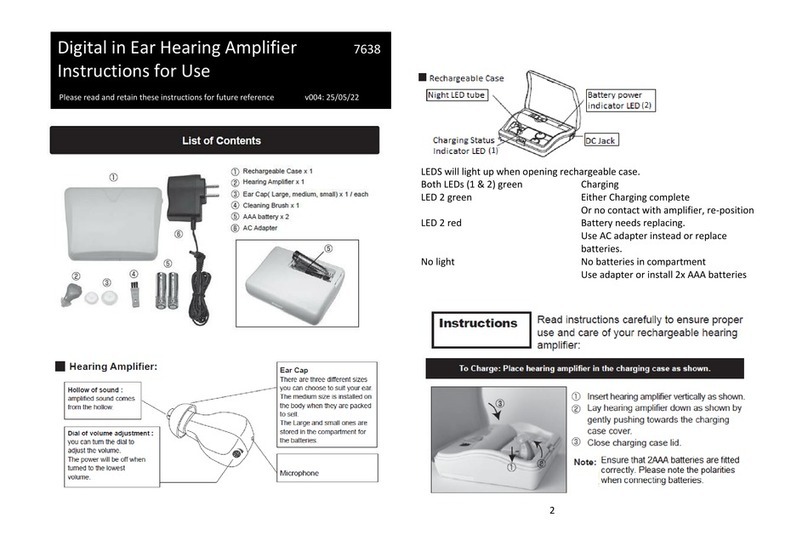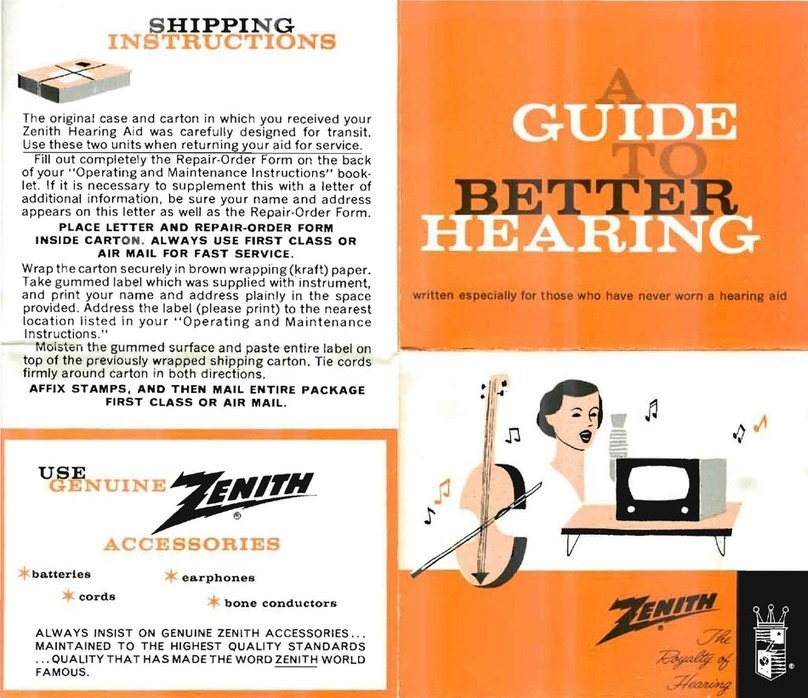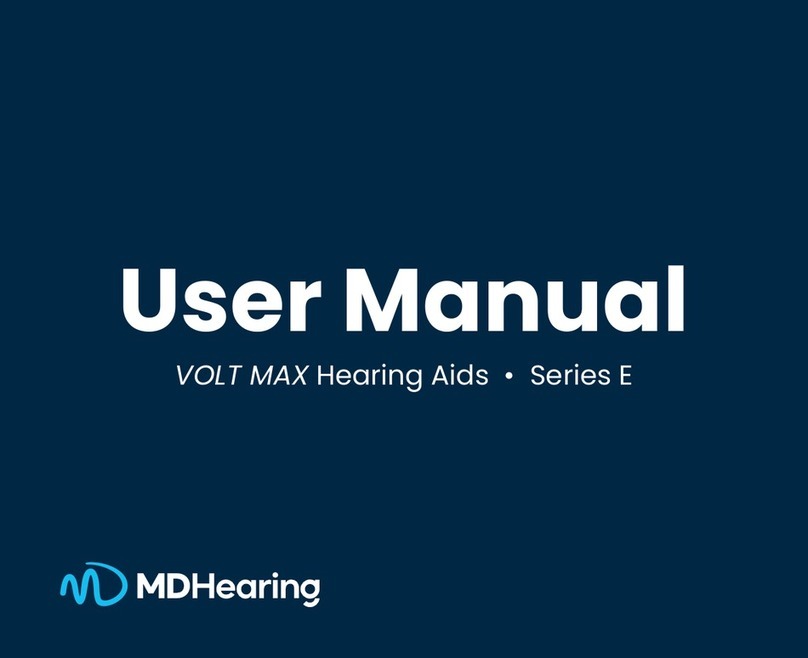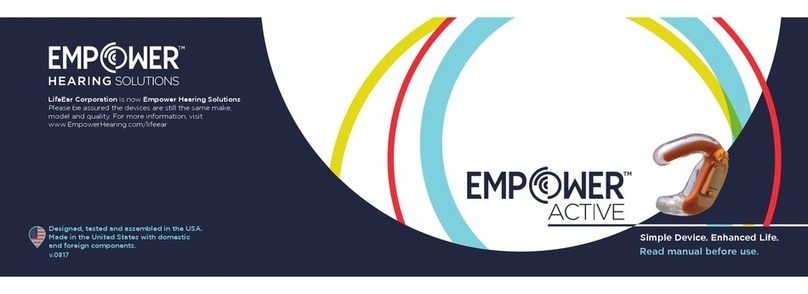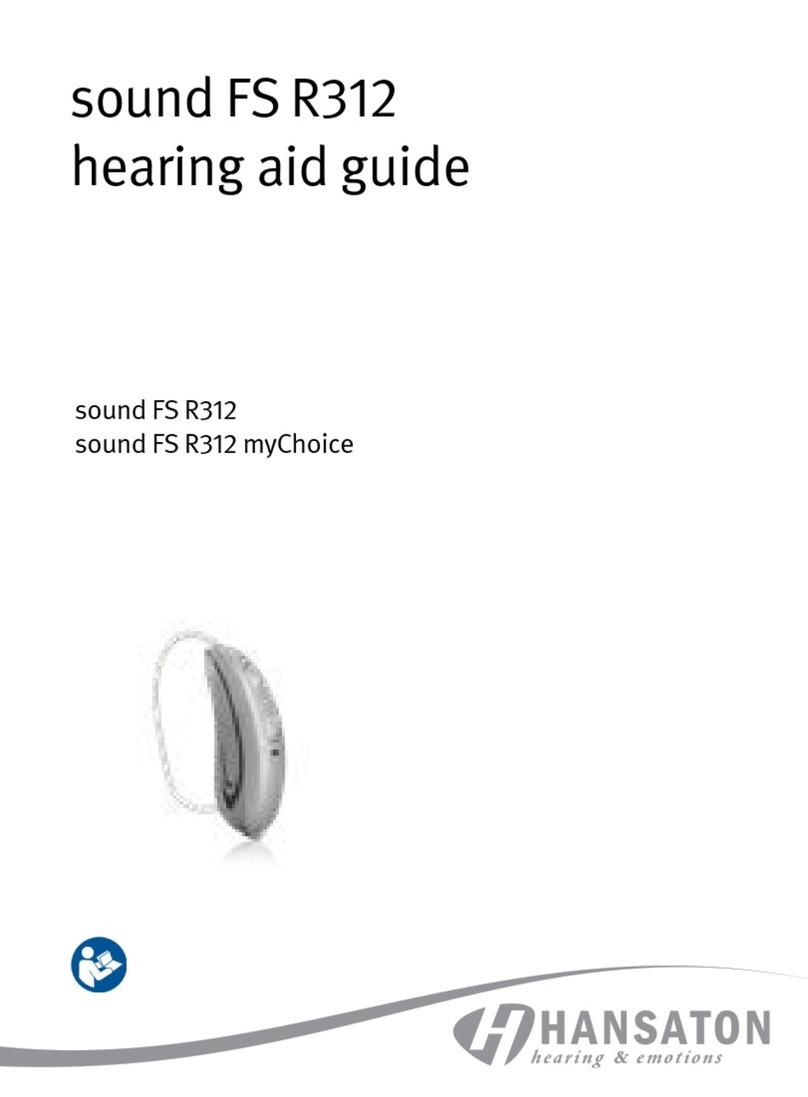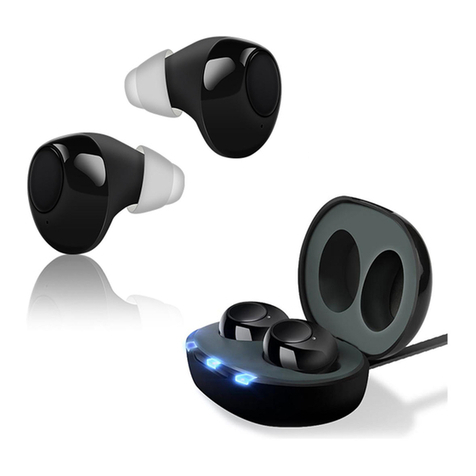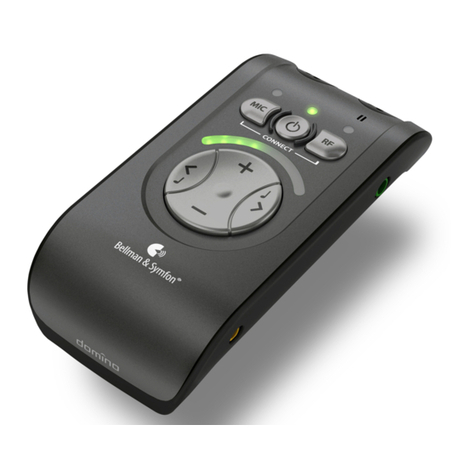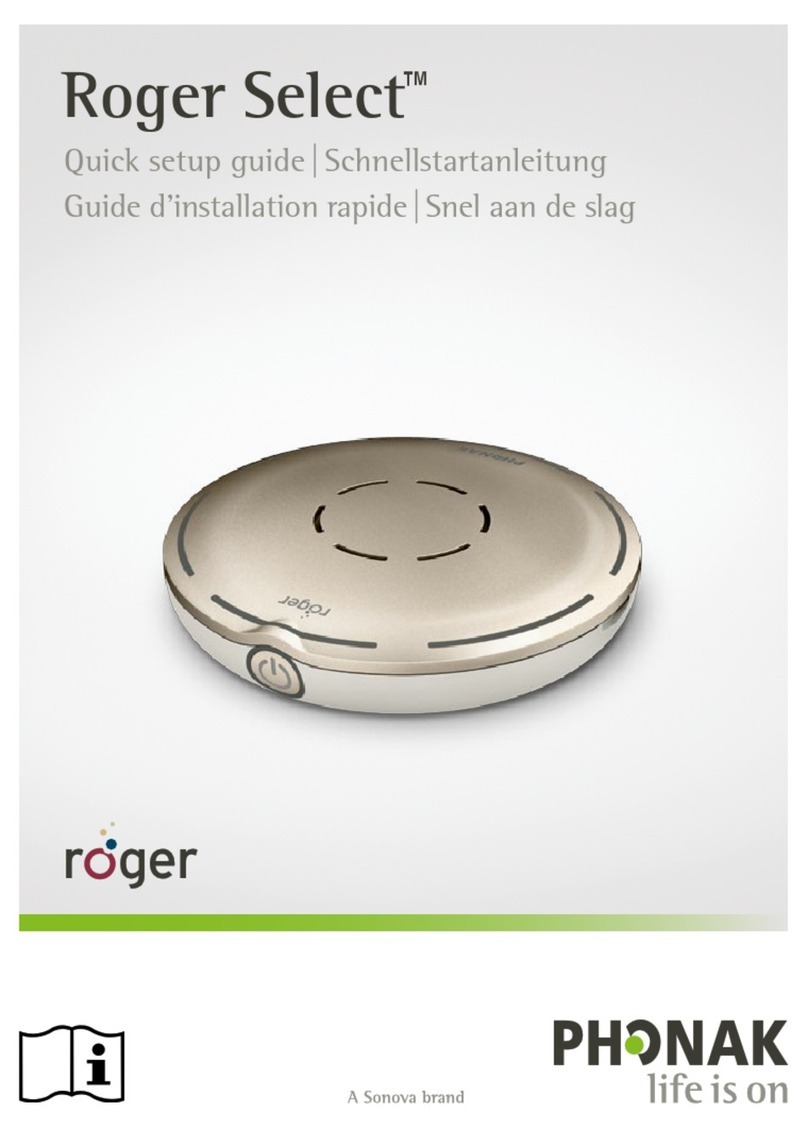Audibel LX User manual

OperatiOns Manual

Now, for the first time, Audibel is offering a lifetime warranty on
the circuit of the new LX hearing aid. The hearing aid circuit is
covered under warranty for the life of the product.
The warranty commences on the actual date of sale to the patient
and is valid only for as long as the patient owns the instrument as
registered by specific serial number.
The LX Lifetime Circuit Warranty is not transferable and does
not apply to transducers, cases or mechanical components.

table Of COntents
IDENTIFICATION
Features, Controls and Identification............................2
PREPARATION
Batteries ....................................................................3
Battery Indicator.........................................................4
Insertion and Removal.................................................5
OPERATION
On, Off and Volume Levels ..........................................6
Multimemory Settings .................................................7
Directional Settings.....................................................8
Telephone Use............................................................8
Summary of Settings..................................................10
HEARING SYSTEM CARE
Instrument Care .......................................................12
Service and Repair ....................................................13
Troubleshooting Guide..............................................14
TIPS FOR BETTER COMMUNICATION
For You....................................................................15
For Your Family and Friends.......................................15
FDA INFORMATION
Required Information................................................16
1

2
Your hearing system
may include:
1. Hearing Instrument
2. Cable
3. Receiver
4. Microphones
5. Multimemory Button
6. Battery Compartment
(on/off control)
7. Retention Lock
Your hearing system can be
identified by:
8. Location of serial number
9. Location of
manufacturer’s name/
model name
10. Location of left/right
side indicator
11. Instant Fit Earbud
identifiCatiOn
Features, Controls and Identification
8
9
10
11
6
1
2
4
5
3
7

3
preparatiOn
Batteries
Your hearing system uses a size 312 battery
as its power source. This battery size can
be identified by the brown color code on
the packaging.
To insert or replace the battery:
1. Use the nail grip on the battery door.
2. Open the battery door gently and remove
the old battery.
3. Remove the tab from the new battery.
4. Line up the battery’s plus “+” sign (flat side of the battery)
with the “+” on the battery door.
5. Close the battery door.

4
Battery Indicator
An indicator will sound when the battery’s voltage is low. You
have approximately 20 minutes* to replace the battery. A
different indicator will sound just before the battery
stops working.
* Actual time between low battery indicator and shut down will vary
depending on environmental noise levels and brand of battery used.
Helpful Hints
• NEVERFORCETHEDOORSHUT;thiscouldresultin
seriousdamage;ifthedoorwillnotclosesecurely,checkthat
the battery is inserted correctly
• Donotopenthebatterydoortoofarordamageislikely
to occur
• Disposeofusedbatteriesimmediatelyintheproperwasteor
recycling container
• Batteriescanvaryinsizeandperformance,yourhearingcare
professional is your best source for information
Warnings
Batteries are dangerous if swallowed. To help prevent the
accidental ingestion of batteries:
Keep out of reach of children and pets
Check your medications before taking them –
batteries have been mistaken for pills
Never put batteries in your mouth, as they can easily
be swallowed
National Button Battery Ingestion Hotline:
202-625-3333

5
Insertion and Removal
To insert:
1. Hold the cable at the bend in front
of the receiver with your thumb and
forefinger. Gently insert the receiver
into your ear canal.
2. Carefully place the hearing
instrument behind your ear
wrapping it over the top of your ear.
3. Place the lock inside the bowl of
your ear.
To remove:
1. Remove the lock from the bowl of
your ear.
2. Remove the hearing instrument from
behind your ear.
3. Grasp the receiver with your thumb
and forefinger. Gently pull out of
your ear canal.
Do not pull with the hearing system case
as this may damage the connection.

6
Helpful Hints
• Minorirritationandinflammationmayoccurasyourear
becomesaccustomedtohavinganobjectinit;ifso,please
contact your hearing care professional
• Ifanactualallergicreactionoccurs,contactyourhearing
care professional
• Severeswelling,dischargefromtheear,excessivewax,or
other unusual conditions warrant immediate consultation
with a physician
OperatiOn
On, Off and Volume Levels
To turn ON:
Insert a battery and completely close the battery door.
To turn OFF:
Open the battery door until the battery is no longer touching the
battery contacts.

7
Multimemory Settings
Your hearing care professional can
set up to four hearing programs for
you. These additional programs
are accessed by pressing the
Multimemory button inward.
When you press the Multimemory
button, you may hear an indicator or
tone series indicating the device has
changed to the next program. Your
hearing system has been setup with
the following environments.
Program Tone Voice Environment
1 1 Tone 1 Normal
2 2 Tones 2
3 3 Tones 3
4 4 Tones 4

8
Directional Settings
Your hearing system has directional microphones to help
improve speech understanding in noisy situations.
Your hearing care professional will circle the programmed
directional setting for each memory.
Program Environment
1 Automatic Manual Off
2 Automatic Manual Off
3 Automatic Manual Off
4 Automatic Manual Off
Telephone Use
Your hearing system allows you to comfortably use the telephone
without removing your hearing system.

9
Some hearing aid users have reported a buzzing sound in their
hearing aids when they are using cell phones, indicating that the
cell phone and hearing aid may not be compatible. According
to the ANSI C63.19 standard (ANSI C63.19-2006 American
National Standard Methods of Measurement of Compatibility
Between Wireless Communications Devices and Hearing Aids),
the compatibility of a particular hearing aid and cell phone can
be predicted by adding the rating for the hearing aid immunity to
the rating for the cell phone emissions. For example, the sum of
a hearing aid rating of 2 (M2) and a telephone rating of 3 (M3)
would result in a combined rating of 5. Any combined rating that
equalsatleast5wouldprovide“normaluse”;acombinedrating
of 6 or greater would indicate “excellent performance.”
Immunity of this hearing aid is at least M2. The equipment
performance measurements, categories and system
classifications are based upon the best information available but
cannot guarantee that all users will be satisfied.
NOTE: The performance of individual hearing aids may vary
with individual cell phones. Therefore, please try this hearing
aid with your cell phone or, if you are purchasing a new phone,
be sure to try it with your hearing aid prior to purchase. For
additional guidance, please ask your cell phone provider for
the booklet entitled “Hearing Aid Compatibility with Digital
Wireless Cell Phones.”

10
Summary of Settings
ENVIRONMENT DIRECTIONAL SETTING INDICATOR ON INDICATOR TYPE
Program 1 Normal
Off
Automatic
Manual
Yes
No
Speech (One)
1 Tone
Program 2
Off
Automatic
Manual
Yes
No
Speech (Two)
2 Tones
Tone Series
Program 3
Off
Automatic
Manual
Yes
No
Speech (Three)
3 Tones
Tone Series
Program 4
Off
Automatic
Manual
Yes
No
Speech (Four)
4 Tones
Tone Series
Low Battery — — Yes
No
Speech (Battery)
Tone Series
Battery End of Life — — Yes
No
Speech (Shutdown)
Sustained Tone
Self Check — — Yes
No
Speech (Good/Make Appointment)
Tone Series
Reminder — — Yes
No
Speech (Make Appointment)
Tone Series

11
Summary of Settings
ENVIRONMENT DIRECTIONAL SETTING INDICATOR ON INDICATOR TYPE
Program 1 Normal
Off
Automatic
Manual
Yes
No
Speech (One)
1 Tone
Program 2
Off
Automatic
Manual
Yes
No
Speech (Two)
2 Tones
Tone Series
Program 3
Off
Automatic
Manual
Yes
No
Speech (Three)
3 Tones
Tone Series
Program 4
Off
Automatic
Manual
Yes
No
Speech (Four)
4 Tones
Tone Series
Low Battery — — Yes
No
Speech (Battery)
Tone Series
Battery End of Life — — Yes
No
Speech (Shutdown)
Sustained Tone
Self Check — — Yes
No
Speech (Good/Make Appointment)
Tone Series
Reminder — — Yes
No
Speech (Make Appointment)
Tone Series

12
Hearing systeM Care
Instrument Care
Do your best to keep your hearing instrument clean at all
times. Heat, moisture and foreign substances can result in
poor performance.
• Useacleaningbrushorsoftclothtocleandebris
from around the switches, microphone and battery
compartment;inspectthereceiver,InstantFitEarbudand
Wax Guard regularly
• IftheWaxGuardorInstantFitEarbudismissing,contact
your hearing care professional immediately to schedule an
appointment for otoscopy
• Neverusewater,solvents,cleaningfluidsoroiltoclean
your instrument
Your hearing care professional can provide further information
on additional maintenance procedures for your hearing system
if needed.
Helpful Hints
• Whennotwearingyourhearingsystem,openthebattery
door to allow moisture to evaporate
• Whennotinuse,removethebatteriescompletely;place
your hearing system in the storage container and store:
– In a dry, safe place
– Away from direct sunlight or heat to avoid
extreme temperatures

13
– Where you can easily find them
– Safely out of reach of pets and children
• Donottakeapartyourhearinginstrumentsorinsertthe
cleaning tools inside them
Service and Repair
If, for any reason, your hearing system does not operate
properly, do NOT attempt to fix it yourself. Not only are you
likely to violate any applicable warranties or insurance, you
could easily cause further damage.
Should your hearing system fail or perform poorly, check the
guide on the next page for possible solutions. If problems
continue, contact your hearing care professional for advice and
assistance. He or she is able to solve many common problems
right in his or her office or clinic.

14
Troubleshooting Guide
SYMPTOM POSSIBLE
CAUSES
SOLUTIONS
Not Loud Enough
Low battery Replace battery
Earwax buildup Clean or replace
Wax Guard
as needed
Improper insertion Check that receiver
is properly placed in
the ear canal
Hearing change Contact your hearing
care professional
Inconsistent
Performance
Low battery Replace battery
Earwax buildup Clean or replace
Wax Guard
as needed
Unclear,
Distorted
Performance
Low battery Replace battery
Earwax buildup Clean or replace
Wax Guard as
needed
Defective hearing
instrument Contact your hearing
care professional
Dead
Low battery Replace battery
Earwax buildup Clean or replace
Wax Guard
as needed

15
tips fOr better COMMuniCatiOn
Your hearing care professional will recommend an appropriate
schedule to help you adapt to your new hearing system. It will
take practice, time and patience for your brain to adapt to the
new sounds that your hearing system provides.
Please review the following simple communication tips:
For You
• Moveclosertoandlookatthespeaker
• Backgroundnoisesmaybefrustratingatfirst;remember,
you have not heard them for a while
• Developrealisticexpectationsofwhatyourhearing
instruments can and cannot do
• Betterhearingwithhearinginstrumentsisalearnedskill
combining desire, practice and patience
For Your Family and Friends
Your family and friends are also affected by your hearing loss.
Request that they:
• Getyourfullattentionbeforebeginningtospeak
• Speakclearlyandatanormalrateandlevel;shoutingcan
actually make understanding more difficult
• Rephraseratherthanrepeatthesamewords;different
words may be easier to understand

16
fda infOrMatiOn
Required Information
The following additional information is provided in compliance with U.S. Food
and Drug Administration (FDA) regulations:
WARNING TO HEARING AID DISPENSERS. A hearing aid dispenser
should advise a prospective hearing aid user to consult promptly with a licensed
physician (preferably an ear specialist) before dispensing a hearing aid if the
hearing aid dispenser determines through inquiry, actual observation, or review
of any other available information concerning the prospective user, that the
prospective user has any of the following conditions:
i. Visible congenital or traumatic deformity of the ear.
ii. History of active drainage from the ear within the previous 90 days.
iii. History of sudden or rapidly progressive hearing loss within the previous
90 days.
iv. Acute or chronic dizziness.
v. Unilateral hearing loss of sudden or recent onset within the previous
90 days.
vi. Audiometric air-bone gap equal to or greater than 15 decibels at
500 Hertz (Hz), 1,000 Hz and 2,000 Hz.
vii. Visible evidence of significant cerumen accumulation or a foreign body in
the ear canal.
viii. Pain or discomfort in the ear.
RF IMMUNITY LEVEL. These hearing instruments have a cell phone
immunity rating of M4. For your cell phone to be compatible with these hearing
instruments, the cell phone needs an immunity rating of M1 or higher. Please
consult your cell phone specifications for your cell phone immunity rating.
IMPORTANT NOTICE FOR PROSPECTIVE HEARING AID USERS.
Good health practice requires that a person with a hearing loss have a medical
evaluation by a licensed physician (preferably a physician who specializes
in diseases of the ear) before purchasing a hearing aid. Licensed physicians
who specialize in diseases of the ear are often referred to as otolaryngologists,
otologists, or otorhynolaryngologists. The purpose of the medical evaluation
is to assure that all medically treatable conditions that may affect hearing are
identified and treated before the hearing aid is purchased.

17
Following the medical evaluation, the physician will give you a written statement
that states that your hearing loss has been medically evaluated and that you may
be considered a candidate for a hearing aid. The physician will refer you to an
audiologist or hearing aid dispenser, as appropriate, for a hearing aid evaluation.
The audiologist or hearing aid dispenser will conduct a hearing aid evaluation
to assess your ability to hear with and without a hearing aid. The hearing aid
evaluation will enable the audiologist or dispenser to select and fit a hearing aid
to your individual needs.
If you have reservations about your ability to adapt to amplification, you should
inquire about the availability of a trial-rental or purchase-option program.
Many hearing aid dispensers now offer programs that permit you to wear a
hearing aid for a period of time for a nominal fee after which you may decide if
you want to purchase the hearing aid.
Federal law restricts the sale of hearing aids to those individuals who have
obtained a medical evaluation from a licensed physician. Federal law permits a
fully informed adult to sign a waiver statement declining the medical evaluation
for religious or personal beliefs that preclude consultation with a physician.
The exercise of such a waiver is not in your best health interest and its use is
strongly discouraged.
A hearing aid will not restore normal hearing and will not prevent or improve a
hearing impairment resulting from organic conditions. In most cases infrequent
use of a hearing aid does not permit a user to attain full benefit from it.
CHILDREN WITH HEARING LOSS. In addition to seeing a physician for
a medical evaluation, a child with a hearing loss should be directed to an
audiologist for evaluation and rehabilitation since hearing loss may cause
problems in language development and the educational and social growth of
a child. An audiologist is qualified by training and experience to assist in the
evaluation and rehabilitation of a child with a hearing loss.
Audibel
6700 Washington Avenue South
Eden Prairie, MN 55344
www.audibel.com

©2008 Audibel All Rights Reserved
83729-010 3/08 BKLT0063-00-EE-AB Rev. A
Table of contents
Other Audibel Hearing Aid manuals
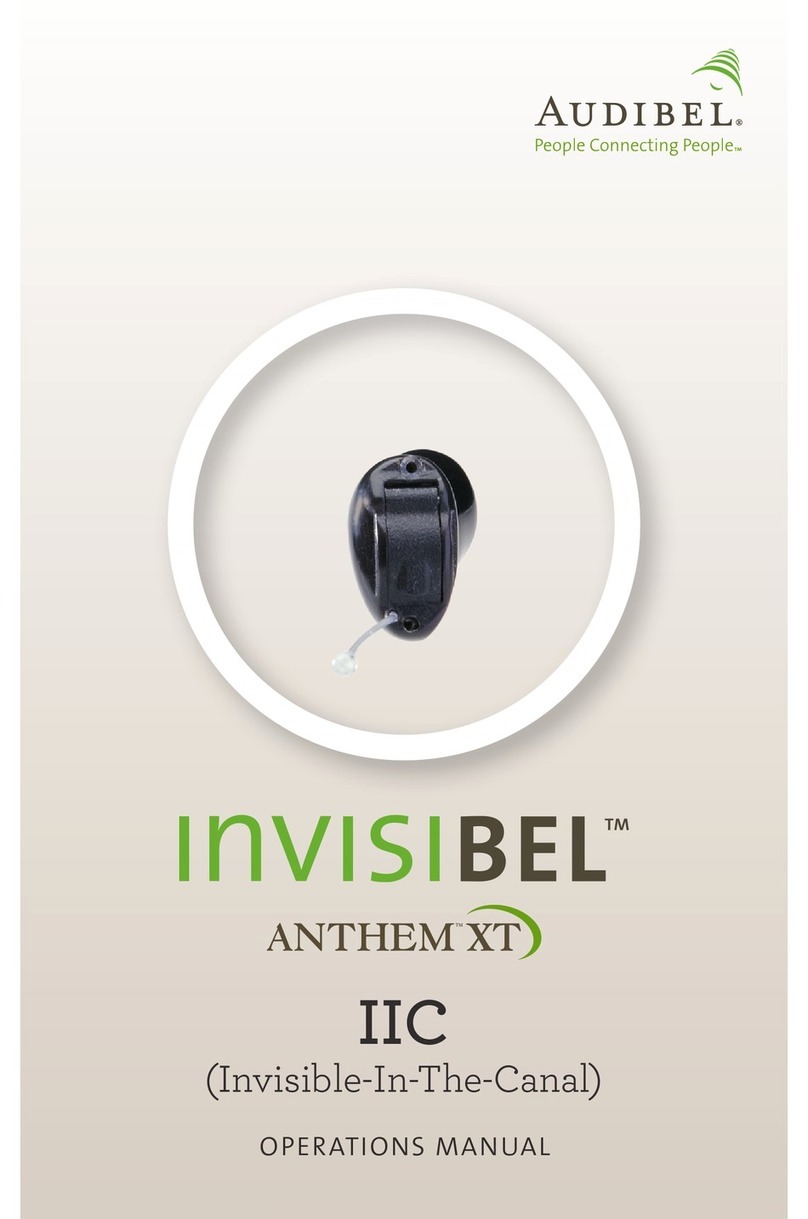
Audibel
Audibel invisibel anthem xt User manual

Audibel
Audibel SurfLink Mini Mobil User manual

Audibel
Audibel Virtue User manual

Audibel
Audibel A4 iQ R User manual
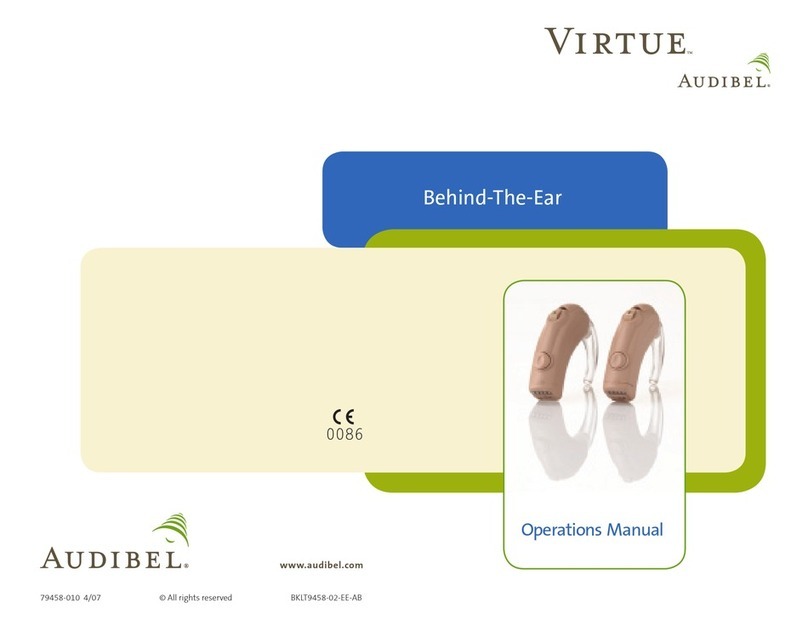
Audibel
Audibel Virtue User manual
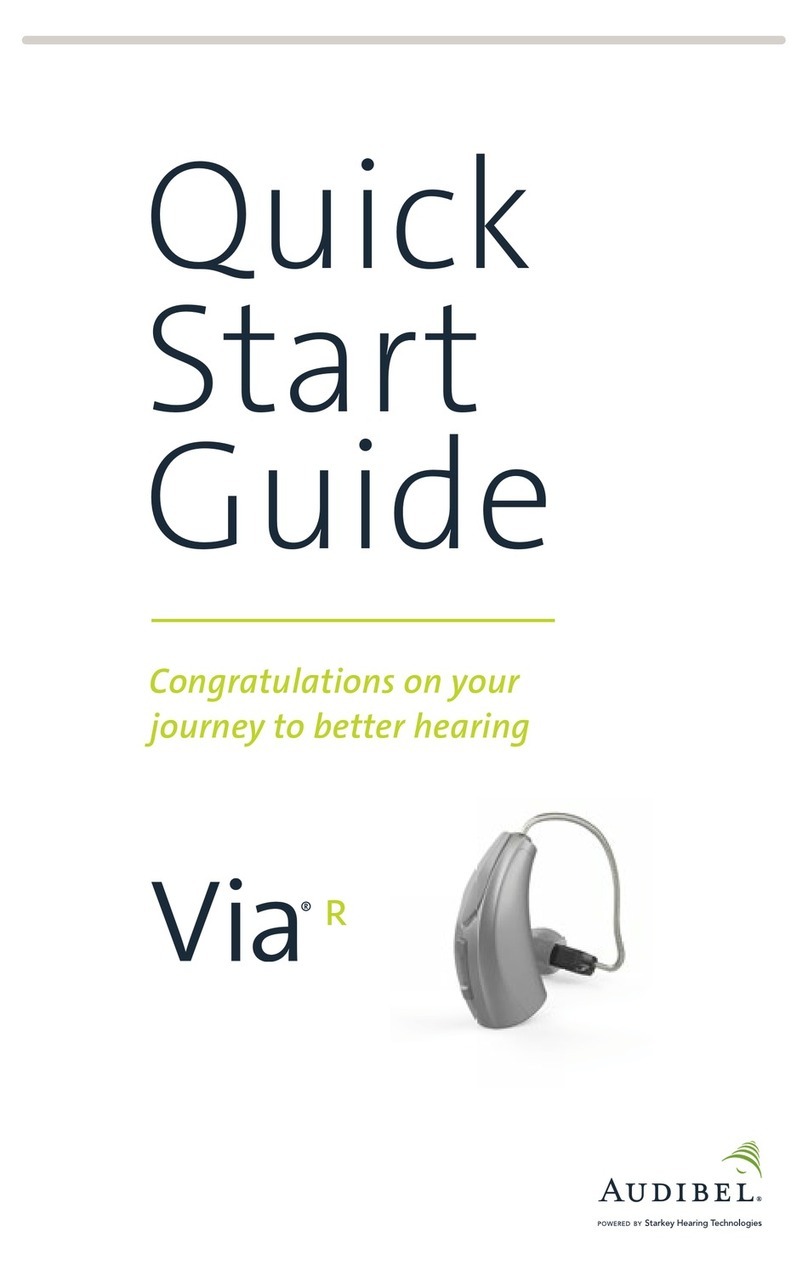
Audibel
Audibel Via Rechargeable User manual
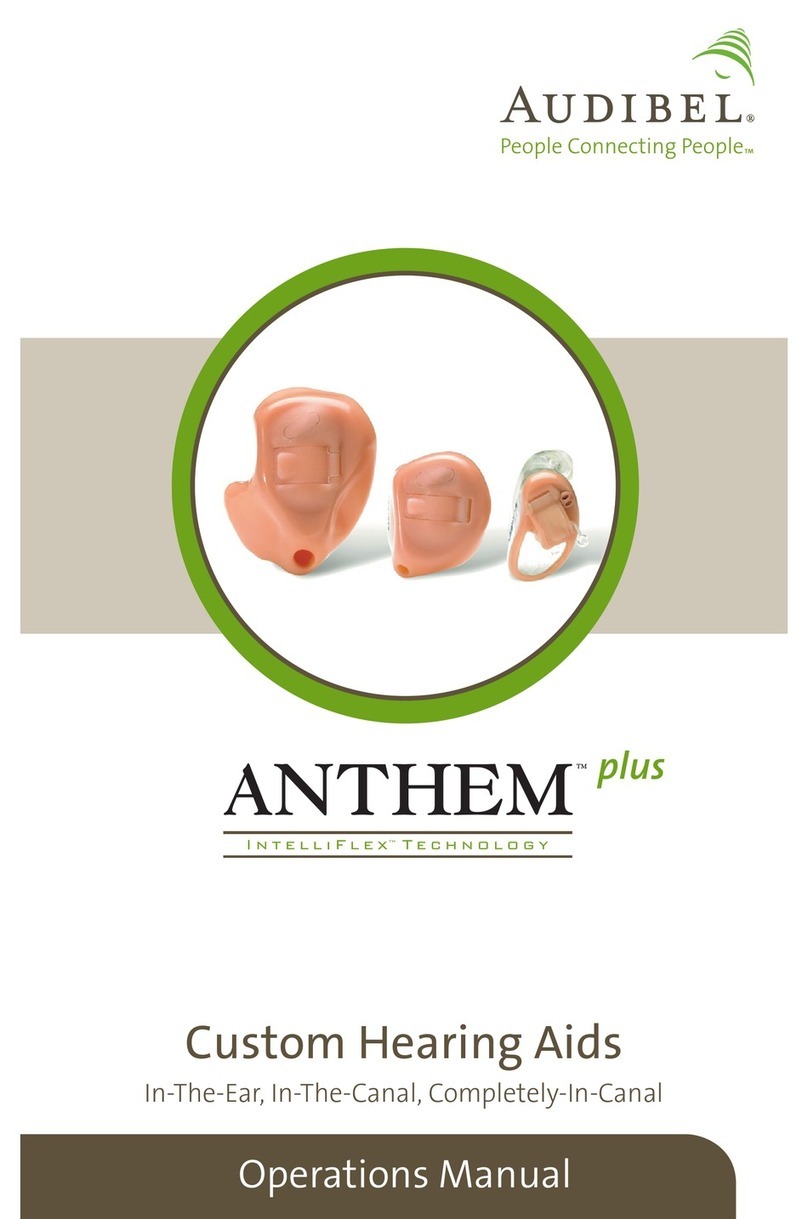
Audibel
Audibel Anthem User manual

Audibel
Audibel Anthem User manual
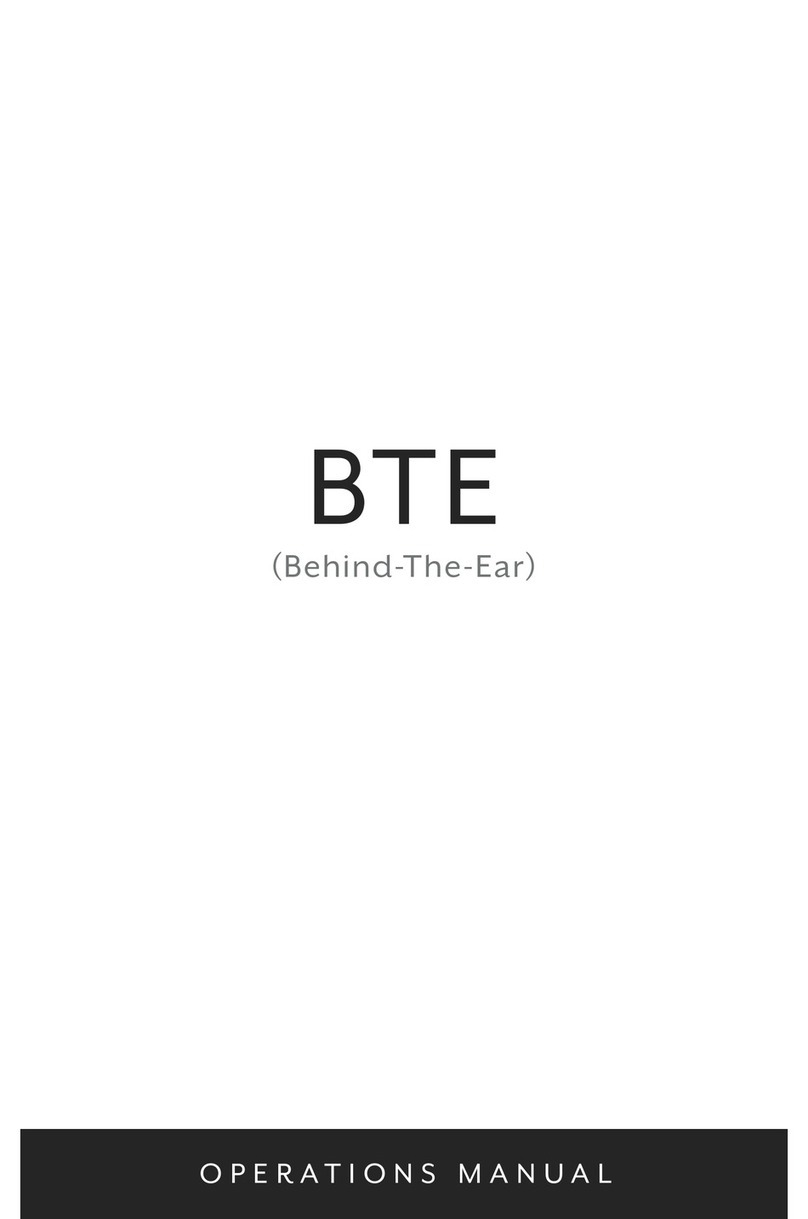
Audibel
Audibel BTE User manual
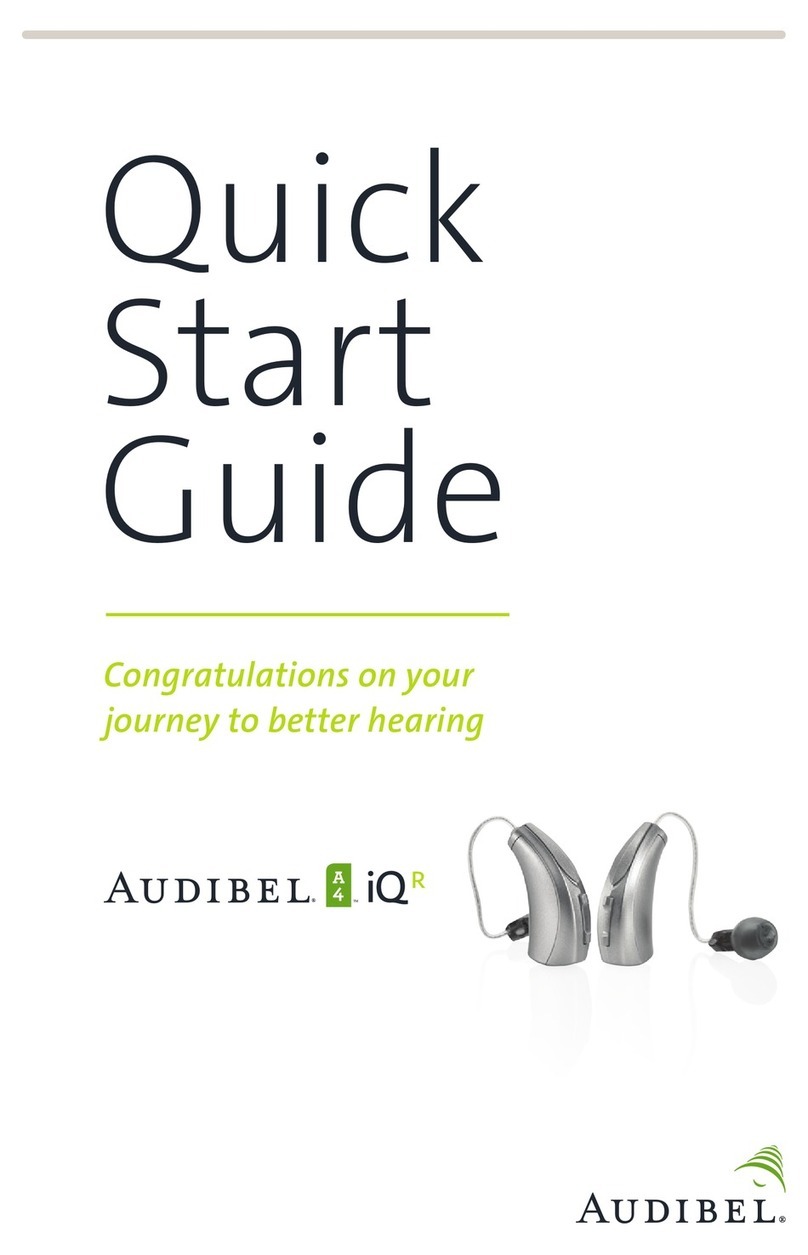
Audibel
Audibel A4 iQ R User manual
